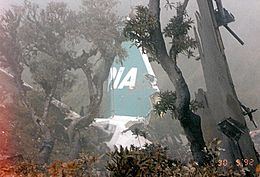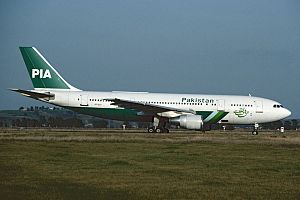Pakistan International Airlines Flight 268 facts for kids

Wreckage of AP-BCP's tail section
|
|
| Accident summary | |
|---|---|
| Date | 28 September 1992 |
| Summary | Controlled flight into terrain due to pilot error |
| Place | Bhattedanda, Nepal 27°31′58″N 85°17′05″E / 27.53278°N 85.28472°E |
| Passengers | 155 |
| Crew | 12 |
| Fatalities | 167 |
| Survivors | 0 |
| Aircraft type | Airbus A300B4-203 |
| Airline/user | Pakistan International Airlines |
| Registration | AP-BCP |
| Flew from | Jinnah International Airport |
| Flying to | Tribhuvan International Airport |
Pakistan International Airlines Flight 268 was a large airplane called an Airbus A300. On September 28, 1992, this plane, with the registration number AP-BCP, crashed as it was getting ready to land at Tribhuvan International Airport in Kathmandu, Nepal. Sadly, all 167 people on board died in the accident. This crash is the worst in the history of Pakistan International Airlines. It is also the deadliest plane crash ever to happen in Nepal.
Contents
The Aircraft and Its Crew
The airplane involved in the accident was an Airbus A300B4-203. It was 16 years old and had the registration number AP-BCP. The plane was built in 1976. It had flown for a total of 39,045 hours and had landed 19,172 times before the crash. Over the years, this aircraft was used by several different airlines before joining Pakistan International Airlines in 1986.
The flight crew included:
- Captain Iftikhar Janjua: He was 49 years old and had a lot of flying experience, with 13,192 hours in the air. More than 6,000 of those hours were on the Airbus A300.
- First Officer Hassan Akhtar: He was 38 years old and had 5,849 flight hours. He had flown the Airbus A300 for 1,469 hours.
- Two Flight Engineers: One was 40 years old and had 5,289 flight hours. The other, Muhammad Ashraf, was 42 and had 8,220 flight hours. Both had thousands of hours on the Airbus A300.
What Happened During the Flight
Flight 268 left Karachi, Pakistan, at 11:13 AM, heading for Kathmandu. When the plane reached Nepal, the pilots talked to air traffic control. They were told to use a specific way to approach the airport from the south, called the Sierra approach.
This approach required the plane to fly over a point called "Romeo" at 15,000 feet. This point was 41 miles south of Kathmandu's airport. From there, the plane was supposed to fly down in seven steps. It needed to be at 9,500 feet when it reached a point called "Sierra," which was 10 miles from the airport. This special approach helped planes fly safely over the Mahabharat Range, which is a mountain range south of Kathmandu.
However, shortly after reporting they were at the 10-mile mark, the plane crashed. At about 2:30 PM, the aircraft hit the side of a mountain at Bhattedanda. The mountain was 8,250 feet tall, and the plane crashed at about 7,300 feet. The impact was very strong, and the plane broke apart. Everyone on board died instantly. The tail of the plane broke off and fell into the forest below.
This accident happened just 59 days after another plane, Thai Airways International Flight 311, crashed near Kathmandu.
People on Board
Most of the people who died were from Europe, Nepal, and other countries. The table below shows the number of passengers and crew from different nationalities.
| Nationality | Passengers | Crew | Total |
|---|---|---|---|
| United Kingdom | 36 | - | 36 |
| Nepal | 30 | - | 30 |
| Spain | 30 | - | 30 |
| Pakistan | 11 | 12 | 23 |
| Netherlands | 14 | - | 14 |
| Other Europeans | 14 | - | 14 |
| Bangladesh | 4 | - | 4 |
| United States | 3 | - | 3 |
| Canada | 2 | - | 2 |
| Unknown | 2 | - | 2 |
| Japan | 1 | - | 1 |
| New Zealand | 1 | - | 1 |
| Total | 155 | 12 | 167 |
Investigation and Causes of the Crash
After the crash, the Nepali Military helped investigators find the plane's black boxes. These devices record flight data and cockpit sounds. The investigation was led by Andrew Robinson from the Air Accident Investigation Branch (AAIB). The black boxes were sent to Paris to be analyzed.
Witnesses near the crash site said there was no strong wind, rain, or thunderstorms at the time. Investigators also found no technical problems with the plane itself. They also ruled out the possibility of terrorism.
Investigators looked at the data from the flight data recorder. It showed that the plane started its descent (going down) too early at each step.
- At 16 miles from the airport, the plane was 1,000 feet lower than it should have been.
- At 10 miles (the Sierra point), it was 1,300 feet too low.
Because of this, the plane was flying too low when it reached the Mahabharat Range and crashed into the mountain.
Even though the pilots told air traffic control their altitude correctly, the controllers did not warn them about being too low until just seconds before the crash.
Investigators found that the main cause of the accident was pilot error. The weather was cloudy, making it hard to see. The plane's ground proximity warning system (which warns pilots if they are too close to the ground) did not go off in time because the mountain was so steep.
The maps and instructions for landing at Kathmandu Airport that Pakistan International Airlines pilots used were also found to be unclear. Also, Nepalese air traffic controllers were thought to be too hesitant to step in and tell pilots what to do, even when they saw a problem.
The report suggested that the ICAO should check flight charts and make them more standard. It also recommended that the landing approach to Kathmandu Airport be made simpler.
Memorials
Pakistan International Airlines paid for and helps maintain the Lele PIA Memorial Park. This park is located in Lele, at the base of a mountain about 10 kilometers north of where the crash happened.
A charity organization in the UK, called the Wilkins Memorial Trust, was created to remember a family who died in the crash. This trust provides help to people in Nepal.
Featured in TV Shows
The accident was shown in an episode of the TV series Mayday, also known as Air Crash Investigation. The episode is called "Kathmandu Descent" and was part of Season 20.
See also
 In Spanish: Vuelo 268 de PIA para niños
In Spanish: Vuelo 268 de PIA para niños
- List of accidents and incidents involving commercial aircraft
- Thai Airways International Flight 311
- List of airplane accidents in Nepal
- Off-by-one error


